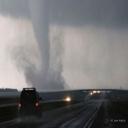Yahoo Answers is shutting down on May 4th, 2021 (Eastern Time) and beginning April 20th, 2021 (Eastern Time) the Yahoo Answers website will be in read-only mode. There will be no changes to other Yahoo properties or services, or your Yahoo account. You can find more information about the Yahoo Answers shutdown and how to download your data on this help page.
Trending News
Why exactly does air move clockwise...?
...around a high pressure system (as opposed to counter-clockwise) and counter-clockwise around a low pressure system (as opposed to clockwise)?
4 Answers
- 1ofSelby'sLv 61 decade agoFavorite Answer
Good question Mr Weather. Here is the answer you deserve. Air first begins to move according to the pressure gradient which acts from high to low pressure. As it begins to move then toward low pressure near the surface two addtional forces begin to act. First friction acts to slow down the speed of the air. Secondly the Coriolis acceleration or force per unit mass acts to turn the movement of the air to the right. If there were no friction the air would come into balance moving parallel to the isobars. This is called geostrophic motion. But with friction the air is slowed, Coriolis is reduced and pressure gradient becomes more dominant such that the wind crosses the isobars at around 10 to 30 degrees as it spirals around and into a low pressure. The opposite effect is occuring around a high pressure area with wind moving clockwise and spiraling outward at around 10 to 30 degrees with the same forces acting on an air parcel.
Source(s): I am a retired research meteorologist, Ph.D, with some 45+ years experience. - Michel VerheugheLv 71 decade ago
The Coriolis effect due to the earth rotation. In the northern hemisphere, any large and slow motion in any direction will be diverted to the right. It is the opposite in the southern hemisphere.
For low pressure, the picture is different: because of the convection on the surface, the air masses will first be diverted to the right but at such a speed that it will fall in an equilibrium between the centrifugal force and the convective force at the center of the low. As a result, the wind turns counter-clockwise around a cyclonic low.
An old sailor's principle, valid in the northern hemisphere, is to stand with the wind from behind and look at the clouds. If they come from the left, a low is approaching - else, it is going away. That is because while up there (where the clouds are) the wind turns in a circle, due to the surface's drag, it falls more directly toward the center of the low where you stand.





